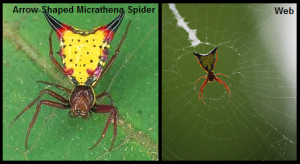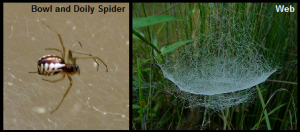These Spiders Weave Unique Webs! (Part 1)
Five Virginia spiders weave unique webs: the Arrow-Shaped Micrathena Spider, the Black and Yellow Garden Spider, the Bowl and Doily Spider, and the Grass Spider. Today we’ll talk about the first three.
Arrow-Shaped Micrathena Spider
Web Design: Arrow-Shaped Micrathena Spiders create large, circular webs, common to all “Orb Weavers”. However, their webs have a huge hole in the middle where the spider is found hanging. The hole has a short zigzag band down the middle to strengthen the web above where the spider sits. While in the web, the spider can be mistaken for a leaf, bark, or a bit of wood. These spider eat mostly tiny flying insects that get caught in their sticky web.
Favorite Hiding Spots:
- Most commonly found in the middle of the web
- In woodlands and gardens
 Defense Mechanism: Arrow-Shaped Micrathena Spiders have special spines on their back that act like armor in order to protect them from their predators, which include birds, lizards, and other hungry animals. However, despite this “armor”, these spiders are the favorite snack of the Mud Dauber Wasp, which paralyzes them and encases them in a mud nest for a late night snack! If their web is disturbed they may also drop into the leaf litter below their nests to escape.
Defense Mechanism: Arrow-Shaped Micrathena Spiders have special spines on their back that act like armor in order to protect them from their predators, which include birds, lizards, and other hungry animals. However, despite this “armor”, these spiders are the favorite snack of the Mud Dauber Wasp, which paralyzes them and encases them in a mud nest for a late night snack! If their web is disturbed they may also drop into the leaf litter below their nests to escape.
Fun Fact: This spiders’ name originates from Greek and Latin. “Micrathena” is the Greek adjective for “small” as well as the name of the goddess Athena (who wore armor and was also a weaver). Additionally, the scientific name is “Micrathena sagittata”, with “sagittata” being Latin for “arrowed”.
Black and Yellow Garden Spider
Web Design: Black and Yellow Garden Spiders are also a type of “Orb Weaver”, meaning that they spin large circular webs. Like the Arrow-Shaped Micrathena, these webs also have a short zigzag band down the middle in order to strengthen the middle of the web, which is where the spider sits. However, these webs do not have a large hole in the middle of them. This web is great for catching small flying insects, such as flies, grasshoppers, crickets, wasps, and bees. If movement is detected, the spider will wave or vibrate the web in order to ensnare its prey. The insect is then immediately wrapped up tightly with swaths of silk, then bitten by the spider in order to subdue it.
Favorite Hiding Spots:
- Gardens
- Open fields
 Defense mechanism: After reaching maturity, the coloration of these spiders as well as the large size of their webs help them to blend in to gardens and fields. It is also theorized that the large zigzag pattern in the center of the web is there to be seen by birds so that they don’t fly into the web. The zigzag might also be used to help camouflage the spider. If threatened, these spiders will immediately drop off the web and hide on the ground.
Defense mechanism: After reaching maturity, the coloration of these spiders as well as the large size of their webs help them to blend in to gardens and fields. It is also theorized that the large zigzag pattern in the center of the web is there to be seen by birds so that they don’t fly into the web. The zigzag might also be used to help camouflage the spider. If threatened, these spiders will immediately drop off the web and hide on the ground.
Fun Fact: In case these spider lose a leg or two, they are able to regenerate them!
Bowl and Doily Spider
Web Design: Bowl and Doily Spiders are named after the type of web they weave, which is a “sheet web” in the shape of a bowl on top of a doily. Male and female spiders will usually be found hanging peacefully side by side between the bowl and doily in the same web, during the summer season. The victims of this beautifully intricate web are usually small flying or crawling insects. In addition to the bowl and doily, the web has trap lines that are constructed above and around the bowl. When an insect hits the trap lines, they stumble into the bowl of the web where the spiders bite them from below. The insect is then wrapped in more silk and saved for dinner!
Favorite Hiding Spots:
- Shrubbery, especially Boxwood bushes and Holly trees
- The spider can be found between the bowl and doily part of the web
 Defense Mechanism: Bowl and Doily Spiders hide in the middle of the web, in between the bowl and the doily, both of which protect it from predators. If the web is disturbed, the spiders will drop off of the web or rapidly run away and hide in nearby bushes.
Defense Mechanism: Bowl and Doily Spiders hide in the middle of the web, in between the bowl and the doily, both of which protect it from predators. If the web is disturbed, the spiders will drop off of the web or rapidly run away and hide in nearby bushes.
Fun Fact: This intricate web can be compared to a small circus net that is used as a safety net for acrobats, except the poor insects wont be falling to safety!
Regardless of what species of spider that you’re having an issue with, PermaTreat is able to take care of your problem!


































































